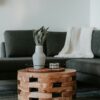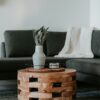Have you ever considered how much personality your coffee table adds to your living room? This often-underestimated piece of furniture is not just a functional surface but can also be a significant contributor to the overall aesthetic of your living space. Join me as we embark on a journey to discover the world of modern coffee tables, understanding their designs, materials, and roles in enhancing our homes.
Understanding the Role of Coffee Tables in Modern Living Rooms
Coffee tables are more than just a surface to hold your coffee cup or stack of magazines. They can serve as a focal point in your living room, bringing together your seating arrangements harmoniously. In modern living rooms, the coffee table is a canvas for self-expression, capable of showcasing your style, preferences, and even personality.
Choosing the right coffee table involves considering how it will complement your decor. From minimalistic designs to intricate artistic pieces, the options are varied, catering to different tastes and functions.
Functional Aspects of Coffee Tables
Let’s start by discussing the primary functions coffee tables serve. On a functional level, these tables provide a convenient spot for placing drinks, snacks, books, and remote controls. Additionally, some coffee tables come with storage, making them perfect for tucking away living room clutter, whether it’s magazines, TV remotes, or children’s toys.
Aesthetic Contributions to Living Spaces
Beyond functionality, coffee tables often act as style statements. They can add a touch of elegance, a splash of color, or a unique shape to your room. The right coffee table design can either blend seamlessly with your other furniture or stand out as an eye-catching centerpiece.
Materials Used in Modern Coffee Tables
Material selection plays a crucial role in determining not just the appearance of a coffee table but also its durability and maintenance requirements. Let’s dive deeper into some of the popular materials used in modern coffee tables.
Wood: The Timeless Classic
Wooden coffee tables are a staple in home decor thanks to their durability, warmth, and versatility. The beauty of wood lies in its natural grains, which can add warmth and texture to any room. Types of wood used range from oak and walnut to more exotic varieties such as rosewood and mahogany.
Pros and Cons of Wooden Coffee Tables
One advantage of wooden tables is their timeless appeal and ability to suit various interior styles, from rustic to contemporary. However, they may require regular maintenance, such as polishing, and can be prone to scratches and water damage if not properly protected.
Glass: The Chic and Elegant Choice
Glass coffee tables are synonymous with sleek, modern aesthetics. They provide a transparent look that can make a room appear larger and more open—an excellent choice for smaller living spaces.
Pros and Cons of Glass Coffee Tables
While glass tables offer a light and airy feel, they can be challenging to maintain due to smudges and fingerprints. Additionally, care must be taken to avoid chips or cracks, making them less suitable for homes with small children or pets.
Metal: The Industrial Trend
Metal coffee tables can bring an industrial or modern edge to your living room. Materials like stainless steel or aluminum create a robust and distinctive look.
Pros and Cons of Metal Coffee Tables
Metal tables are known for their durability and minimal maintenance. However, they can feel cold or harsh unless paired with softer elements within the room, like textiles or wood.
Mixed Materials: The Best of Both Worlds
For those who can’t decide on one material, mixed-material coffee tables combine elements like wood, glass, and metal. This combination allows for unique designs that can fit various aesthetics, from contemporary to eclectic.
Styles of Modern Coffee Tables
The style of a coffee table is critical to its function as both a practical and decorative piece. Here are some notable styles that can fit different living room designs.
Minimalist: The Clean and Simple Approach
Minimalist coffee tables typically feature clean lines and a lack of ornamentation, focusing on simplicity and functionality. They’re perfect for modern, uncluttered living spaces.
Mid-Century Modern: The Retro Revival
This style draws inspiration from the mid-20th century, characterized by organic shapes, simple forms, and a focus on functionality. Mid-century modern coffee tables often use wood and glass, boasting elegant yet straightforward designs.
Industrial: The Urban Edge
Industrial style takes cues from old factories or urban spaces, employing raw materials like metal and reclaimed wood. These tables often emphasize functionality and durability while exuding a rugged sense of charm.
Scandinavian: The Cozy and Functional
With its roots in Nordic design, the Scandinavian style is all about functionality, simplicity, and comfort. These coffee tables often feature light woods and neutral tones, perfect for creating a cozy and inviting atmosphere.
Rustic: The Warm and Inviting
Rustic coffee tables emphasize natural beauty, often using reclaimed wood or distressed finishes. This style is perfect for creating a warm, homely feel in a living room.
Choosing the Right Coffee Table for Your Living Room
Selecting the ideal coffee table involves more than picking a style or material. Let’s explore the key considerations to keep in mind to ensure your coffee table complements your space perfectly.
Size and Proportion
The size of the coffee table is crucial to maintaining a balanced look in your living room. A table that’s too large can overwhelm the space, while one that’s too small might look out of place. Ideally, the table should be of a height similar to or slightly lower than your sofa’s seat height.
Shape: Round, Square, or Rectangular?
The shape is an important factor, as it can affect the flow and accessibility of the room. Rectangular tables are classic and versatile, fitting well in various layouts. Square tables can work in larger spaces or sections, while round tables offer a softer look and are ideal for smaller or more casual settings.
Functionality: Beyond Just Looks
Consider your needs: Do you require additional storage? Do you entertain guests frequently? Coffee tables with shelves or drawers can be particularly useful in maximizing storage space. On the other hand, a more decorative table might be appropriate for a less-utilitarian room.
Budget Considerations
Coffee tables come in a wide range of price points. Setting a budget beforehand is wise to ensure you find a piece that meets both your aesthetic preferences and practical needs without breaking the bank.
Enhancing Your Living Room with a Coffee Table
Now that we’ve explored types and styles, let’s discuss how to incorporate a coffee table into your living room seamlessly.
Pairing with Sofas and Other Furnishings
When choosing a coffee table, it’s essential to consider how it interacts with existing furniture. The table should complement your sofa’s color, texture, and style, creating a unified aesthetic across the room.
Accessorizing Your Coffee Table
Accessorizing your coffee table can enhance its visual appeal. Consider using decorative trays, books, plants, or sculptures to add layers of interest and personality without cluttering the space.
The Role of Coffee Tables in Defined Spaces
For open-plan living spaces, coffee tables can help define the living area, creating a focal point around which seating and decor are organized. In smaller rooms, they can offer a dual function, serving both aesthetic and practical purposes in limited space.
Current Trends in Modern Coffee Tables
Staying updated with trends can offer inspiration and help inform your purchase. Let’s look at some current trends making waves in the world of coffee tables.
Sustainable Materials and Designs
With an increased focus on sustainability, many modern coffee tables are crafted from eco-friendly materials or feature reclaimed and responsibly sourced wood, aligning with the growing demand for environmentally conscious home decor.
Bold Colors and Finishes
Gone are the days when understated and neutral tones dominated. Today, bold colors and finishes can make your coffee table a statement piece. From metallic sheens to vibrant hues, the options are vast and exciting.
Custom and Artisan Designs
There is a growing appreciation for custom and uniquely crafted coffee tables. These pieces often feature bespoke designs or are handcrafted by artisans, adding a personal touch and uniqueness to your living room.
Maintenance Tips for Long-Lasting Coffee Tables
Finally, a well-maintained coffee table remains a beautiful and functional part of your living room for years. Here are some tips on keeping yours in tip-top condition.
Regular Cleaning and Care
Different materials require different maintenance. Wooden tables benefit from regular polishing, while glass tables need frequent wiping to avoid smudges. For metal tables, ensure you use non-abrasive cleaners to maintain their finish.
Handling Spills and Stains
Quickly addressing spills and stains can prevent long-term damage. For wooden tables, use coasters and placemats to protect the surface from heat and moisture, and clean spills immediately with a soft, damp cloth.
Preventing Scratches and Damage
To avoid scratches, use felt pads under decorative items, and avoid dragging heavy objects across the table surface. Regularly check for loose screws or fixtures that might need tightening to maintain the table’s stability.
In conclusion, modern coffee tables are indeed an essential aspect of living room design, balancing aesthetics with functionality. With the right choice, your coffee table can transform your living space, providing both a stunning centerpiece and a practical surface to enjoy everyday activities. Now, when you next look at your coffee table, hopefully, you’ll see it not only as a piece of furniture but as a statement of your style and a cornerstone of your living room’s ambiance.









